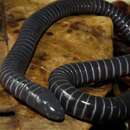en
names in breadcrumbs


Siphonops paulensis és una espècie d'amfibis gimnofions de la família Caeciliidae. Habita a l'Argentina, Bolívia, Brasil i Paraguai. Els seus hàbitats naturals inclouen boscos secs tropicals o subtropicals, sabanes seques i humides, prades a baixa altitud inundades temporalment, plantacions, jardins rurals, àrees urbanes i zones prèviament boscoses ara molt degradades.
Siphonops paulensis, or Boettger's caecilian, is a species of caecilian in the family Siphonopidae. It is found in northern Argentina, Paraguay, eastern Bolivia, and southern Brazil.[2] It lives subterraneously in forests, savannas, shrublands, and grassland. It also adapts to anthropogenic disturbance and can even live in urban gardens. In fact these caecilians have even been recorded to breed and raise their young close to Santa Cruz, a highly populated city.[3] It is a locally common species that is not facing major threats.[1]
{{cite web}}: CS1 maint: multiple names: authors list (link) Siphonops paulensis, or Boettger's caecilian, is a species of caecilian in the family Siphonopidae. It is found in northern Argentina, Paraguay, eastern Bolivia, and southern Brazil. It lives subterraneously in forests, savannas, shrublands, and grassland. It also adapts to anthropogenic disturbance and can even live in urban gardens. In fact these caecilians have even been recorded to breed and raise their young close to Santa Cruz, a highly populated city. It is a locally common species that is not facing major threats.
La cecilio de Boettger aŭ senkrurulo de Sanpaŭlio, Siphonops paulensis, estas specio de cecilio (senkrurulo) de la familio de Sifonopedoj. Ĝi troviĝas en norda Argentino, Paragvajo, orienta Bolivio, kaj suda Brazilo.[1] Ĝi loĝas subtere en arbaroj, savanoj, arbustaroj, kaj herbejoj. Ĝi adaptiĝas ankaŭ al antropogena ĝenado kaj povas loĝi eĉ en urbaj ĝardenoj. Ĝi estas surloke ofta specio kiu ne frontas gravajn minacojn.[2]
 La senkrura Sudamerika cecilio Siphonops paulensis.
La senkrura Sudamerika cecilio Siphonops paulensis. La cecilio de Boettger aŭ senkrurulo de Sanpaŭlio, Siphonops paulensis, estas specio de cecilio (senkrurulo) de la familio de Sifonopedoj. Ĝi troviĝas en norda Argentino, Paragvajo, orienta Bolivio, kaj suda Brazilo. Ĝi loĝas subtere en arbaroj, savanoj, arbustaroj, kaj herbejoj. Ĝi adaptiĝas ankaŭ al antropogena ĝenado kaj povas loĝi eĉ en urbaj ĝardenoj. Ĝi estas surloke ofta specio kiu ne frontas gravajn minacojn.
El cutuchi (Siphonops paulensis) es una especie de anfibio gimnofión de la familia Caeciliidae. Es endémica de América del Sur. Habita en el sur de la provincia de Misiones y en el nordeste de la de Corrientes (Argentina), en el oriente de Bolivia, en la mitad sureste del Brasil y en el nordeste del Paraguay.
Sus hábitats naturales incluyen bosques secos tropicales o subtropicales, sabanas secas y húmedas, praderas a baja altitud inundadas temporalmente, plantaciones, jardines rurales, áreas urbanas y zonas previamente boscosas ahora muy degradadas.
El cutuchi (Siphonops paulensis) es una especie de anfibio gimnofión de la familia Caeciliidae. Es endémica de América del Sur. Habita en el sur de la provincia de Misiones y en el nordeste de la de Corrientes (Argentina), en el oriente de Bolivia, en la mitad sureste del Brasil y en el nordeste del Paraguay.
Sus hábitats naturales incluyen bosques secos tropicales o subtropicales, sabanas secas y húmedas, praderas a baja altitud inundadas temporalmente, plantaciones, jardines rurales, áreas urbanas y zonas previamente boscosas ahora muy degradadas.
Siphonops paulensis Siphonops generoko animalia da. Anfibioen barruko Siphonopidae familian sailkatuta dago, Gymnophiona ordenan.
Siphonops paulensis Siphonops generoko animalia da. Anfibioen barruko Siphonopidae familian sailkatuta dago, Gymnophiona ordenan.
Siphonops paulensis est une espèce de gymnophiones de la famille des Siphonopidae[1].
Cette espèce se rencontre jusqu'à 450 m d'altitude[1] :
Son nom d'espèce, composé de paul et du suffixe latin -ensis, « qui vit dans, qui habite », lui a été donné en référence au lieu de sa découverte, l'État de São Paulo.
Siphonops paulensis est une espèce de gymnophiones de la famille des Siphonopidae.
Siphonops paulensis é uma espécie de anfíbio da família Caeciliidae.
Pode ser encontrada nos seguintes países: Argentina, Bolívia, Brasil e Paraguai.
Siphonops paulensis é uma espécie de anfíbio da família Caeciliidae.
Pode ser encontrada nos seguintes países: Argentina, Bolívia, Brasil e Paraguai.
Черв'яга паранська (Siphonops paulensis) — вид безногих земноводних родини Кільчасті черв'яги. Він поширений у країнах Південної Америки (Аргентина, Болівія, Бразилія і Парагвай). Його природнім середовищем проживання є субтропічні або тропічні сухі ліси, савана, субтропічні або тропічні сухі чагарники, субтропічні або тропічні сезонно вологі або затоплювані низовини, пасовища, плантації, сільські сади.
Черв'яга паранська (Siphonops paulensis) — вид безногих земноводних родини Кільчасті черв'яги. Він поширений у країнах Південної Америки (Аргентина, Болівія, Бразилія і Парагвай). Його природнім середовищем проживання є субтропічні або тропічні сухі ліси, савана, субтропічні або тропічні сухі чагарники, субтропічні або тропічні сезонно вологі або затоплювані низовини, пасовища, плантації, сільські сади.
Ếch giun Boettger (Siphonops paulensis) là một loài không chân trong họ Caeciliidae. Nó được tìm thấy ở Argentina, Bolivia, Brasil, và Paraguay. Các môi trường sống tự nhiên của chúng là các khu rừng khô nhiệt đới hoặc cận nhiệt đới, xavan khô, xavan ẩm, vùng đất có cây bụi nhiệt đới hoặc cận nhiệt đới, đồng cỏ nhiệt đới hoặc cận nhiệt đới vùng ngập nước hoặc lụt theo mùa, các đồn điền, vườn nông thôn, các vùng đô thị, và các khu rừng trước đây bị suy thoái nặng nề.
Phương tiện liên quan tới Siphonops paulensis tại Wikimedia Commons
Ếch giun Boettger (Siphonops paulensis) là một loài không chân trong họ Caeciliidae. Nó được tìm thấy ở Argentina, Bolivia, Brasil, và Paraguay. Các môi trường sống tự nhiên của chúng là các khu rừng khô nhiệt đới hoặc cận nhiệt đới, xavan khô, xavan ẩm, vùng đất có cây bụi nhiệt đới hoặc cận nhiệt đới, đồng cỏ nhiệt đới hoặc cận nhiệt đới vùng ngập nước hoặc lụt theo mùa, các đồn điền, vườn nông thôn, các vùng đô thị, và các khu rừng trước đây bị suy thoái nặng nề.